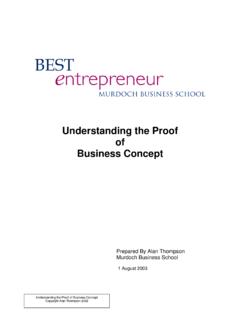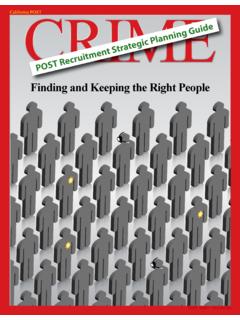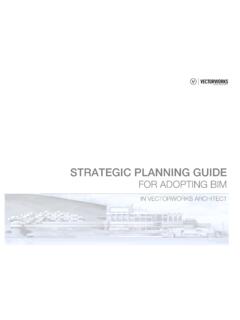Transcription of GUIDE TO BUSINESS PLANNING - United Diversity
1 GUIDE TO BUSINESS PLANNING01 Bus PLANNING 10/11/06 3:18 PM Page iOTHER ECONOMIST BOOKSG uide to Analysing CompaniesGuide to BUSINESS ModellingGuide to Economic IndicatorsGuide to the European UnionGuide to Financial MarketsGuide to Management IdeasNumbers GuideStyle GuideDictionary of BusinessDictionary of EconomicsInternational Dictionary of FinanceBrands and BrandingBusiness EthicsBusiness StrategyChina s StockmarketE-trendsGlobalisationSuccessf ul InnovationSuccessful MergersWall StreetEssential DirectorEssential EconomicsEssential FinanceEssential InternetEssential InvestmentEssential NegotiationPocket AsiaPocket Europe in FiguresPocket World in Figures01 Bus PLANNING 10/11/06 3:18 PM Page iiGUIDE TO BUSINESS PLANNINGG raham FriendandStefan Zehle01 Bus PLANNING 10/11/06 3:18 PM Page iiiTHE ECONOMIST IN ASSOCIATION WITH PROFILE BOOKS LTDP ublished in 2004 by Profile Books Ltd3aExmouth House, Pine Street, London ec1r 0jhCopyright The Economist Newspaper Ltd, 2004 Text copyright Graham Friend and Stefan Zehle, 2004 All rights reserved.
2 Without limiting the rights under copyright reserved above, no part of this publicationmay be reproduced, stored in or introduced into a retrieval system, or transmitted, in any form or by anymeans (electronic, mechanical, photocopying, recording or otherwise), without the prior written permissionof both the copyright owner and the publisher of this greatest care has been taken in compiling this book. However, no responsibility can be accepted by the publishers or compilersfor the accuracy of the information presented. Where opinion is expressed it is that of the authors and does not necessarily coincide with the editorialviews of The Economist in EcoType by MacGuru in Italy byLegoprint Lavis (TN)A CIP catalogue record for this book is available from the British LibraryISBN-10 1 86197 474 4 ISBN-13 978 1 86197 474 701 Bus PLANNING 10/11/06 3:18 PM Page ivContents1 Introduction12 The BUSINESS plan83 The BUSINESS PLANNING process194 strategic planning245 Analysing the environment316 Analysing the firm417 Industry and competitor analysis548 Product and portfolio analysis659 SWOT analysis8510 Generating strategic options8911 Market analysis and strategy9912 Market forecasting10713 The operational plan13714 Modelling the business14415 Accounting principles15016 Completing the financial statements17917 Reviewing the financial statements18718 Evaluating strategic options19919 Funding issues22120 Risk analysis23621 Presenting the BUSINESS plan and obtaining approval24122 Implementing the BUSINESS plan245 Appendix248 Index26301 Bus PLANNING 10/11/06 3.
3 18 PM Page vThis page intentionally left blank 1 IntroductionThis book is designed for those with an inspired idea who wish to translate it into asuccessful new BUSINESS or incorporate it in an existing BUSINESS . Usually, the first challengefor those who want to get a BUSINESS idea off the ground is securing funding. Any investoror those in an existing BUSINESS with responsibility for approving new initiatives willinvariably insist upon seeing a BUSINESS plan before they approve any investment. Thebusiness plan, besides being a prerequisite for gaining access to finance, also provides theblueprint for successfully creating and running the new venture. This book describes abusiness PLANNING process that will support the preparation of a compelling BUSINESS planand the creation of a successful BUSINESS plan describes the BUSINESS s vision and objectives as well as the strategy andtactics that will be employed to achieve them.
4 A plan may also provide the basis foroperational budgets, targets, procedures and management controls. No two businesses areidentical and no two BUSINESS plans are ever exactly the same. This GUIDE examines thedifferent reasons for preparing a BUSINESS plan. It identifies who the potential audiences fora BUSINESS plan are; how they read it; and what things different members of the audiencewill be looking for. The task of writing a BUSINESS plan is a lot easier if you have a templatethat can be tailored to the specific needs of your BUSINESS . Chapter 2 provides one. Alsoexplained is how to design and present a BUSINESS plan to maximise the likelihood of itsgaining approval or the presentation of the final BUSINESS plan is important, ultimately the substanceof the plan is most crucial. The strategies and tactics described in the plan should be theoutputs from a logical and appropriately comprehensive BUSINESS PLANNING process.
5 Themain emphasis of this GUIDE is on the various stages of that process. This book provides apractical step-by-step BUSINESS PLANNING process and a reference for the tools andtechniques necessary to complete it. It begins with an overview of a typical BUSINESS planand the remaining chapters correspond to the stages of the BUSINESS PLANNING processdescribed in Chart on the next process should begin by evaluating the BUSINESS s existing or intended position andthe environment in which it operates, before analysing existing or future customers,competitors and suppliers. The results of the analysis, combined with a set of expectationsabout the future, coupled with creative and innovative thinking, allow the BUSINESS todevelop a range of strategic options designed to achieve its objectives. The evaluation stageincludes developing forecasts (notably for market demand), financial projections and, insome cases, a range of valuations, as well as calculating various measures of BUSINESS PLANNING process can also be used to test alternative ideas and assumptions,as one of the main reasons for PLANNING is to help the BUSINESS prepare for an uncertainfuture.
6 Following stages include an examination of the funding issues and risk analysis,and lastly presenting and gaining approval for the BUSINESS plan, and then implementing of the rapidly changing world in which businessesmust operate, this GUIDE placesconsiderable emphasis on BUSINESS PLANNING in the face of uncertainty and makes use oftechniques such as scenario Bus PLANNING 10/11/06 3:18 PM Page 1 All BUSINESS plans require some form of financial analysis and forecasts for the BUSINESS orproject. Most financial projections are prepared in a spreadsheet package such asMicrosoft s Excel. Chapter 14 describes the generic Excel spreadsheet BUSINESS model thataccompanies this book and that can be used within your own BUSINESS . The model alsoforms the basis for the detailed worked examples that are used to explain the basicprinciples of accounting and the preparation of financial statements in Chapters 15 and INTRODUCTION2 Chart The BUSINESS PLANNING processStrategic review and planMarketing planChange strategy depending on outcome of evaluationStakeholder analysisVision, mission and objectivesEnvironmental analysisAnalysis of the firmIndustry and competitor analysisProduct and portfolio analysisSWOT analysisGeneration of strategic optionsMarket analysis and strategyMarket forecastingOperational planModel the businessEvaluate and select strategyExamine funding issuesPerform risk analysisPresent and approve the BUSINESS planImplement the BUSINESS planChapter 13 Chapters 14 to 17 Chapter 18 Chapter 19 Chapter 20 Chapter 21 Chapter 22 Chapters 11 and 12 Chapters 4 to 1001 Bus PLANNING 10/11/06 3.
7 18 PM Page 2 This book is not, however, about BUSINESS modelling, which is dealt with in The EconomistGuide to BUSINESS THE BOOKA lthough this book provides a step-by-step GUIDE to BUSINESS PLANNING , it can also bedipped into by those wanting to apply the techniques to address a specific businessappraisal or analytical challenge. Chart on the next page provides a quick reference toall the BUSINESS PLANNING techniques used in the book, including the typical applicationsfor each technique and where they can be BUSINESS PLANNING MODELA BUSINESS PLANNING model built in Microsoft s Excel is available for the readers of this download the model visit and follow the simpledownload instructions. There are two versions available. The blank version (Blank Model) isdesigned to help the reader understand and apply the accounting techniques discussed inChapters 15 17. For experienced BUSINESS modellers, this version can be customised to meetthe specific needs of their BUSINESS .
8 There is also a completed version (Complete Model),which represents the end result of working through the examples in the book. A full set ofoutputs from the completed model can be found in the AND BUSINESS MODELLINGWhen considering the forecasting and accounting needs for your own BUSINESS , you arestrongly recommended to gain professional assistance from trained accounting personnel ifthe accounting and modelling issues extend beyond those covered in this book. The banksfrom whom you hope to raise finance may be able to provide assistance with the creationof your financial projections or alternatively you can seek the help of a professionalaccounting firm or management consultancy. You may also be able to obtain help fromgovernment organisations established to support new BUSINESS ventures. The specificdetails of setting up a new company or partnership are beyond the scope of this book, butChapter 13 provides a useful checklist of the issues that should be considered whencreating a new company.
9 The first thing that you should think about, however, is whetheryou are emotionally prepared for the inevitable stress that running your own businessentails. We hope that this book will at least alleviate some of the pressures of preparingyour first BUSINESS the book301 Bus PLANNING 10/11/06 3:18 PM Page 31. INTRODUCTION4 TechniqueBenchmarkingBrand perception mapBusiness/industryattractiveness screenBusiness designCore competenciesCurve fittingDiffusion of innovationDirectional policy matrixDiscounted cash flowEconomies of scaleExperience curveApplicationObtaining financial and operational data from competitors against which a BUSINESS canmeasure its own performance. Helps to set targets and focus improvements on areaswhere this is most 7, page 62 Shows how a brand appeals to a differentiated set of needs. If segmentation is needsbased, the product should score highly against the targeted needs. Relevant fordeveloping the marketing 11, page 105A matrix commonly known as the GE BUSINESS /Industry Attractiveness Screen.
10 It is usedto evaluate the position of a BUSINESS or BUSINESS 8, page 81 The process of establishing a BUSINESS design incorporates elements of strategy andtactics. The BUSINESS design describes the fundamental characteristics of the BUSINESS ,the most crucial of which is how the BUSINESS establishes and maintains sustainablecompetitive 18, page 200 The functions or practices that are central to a BUSINESS . The activity (or activities) thatthe BUSINESS believes it does best. If a BUSINESS s core activity is closely aligned with itscore competencies it is better placed to achieve competitive 6, page 44A form of extrapolation used for market forecasting. It is based on the observation thattechnological and market developments usually follow an s-shaped 12, page 122A model that describes how a new product or service is adopted by a population, mostcommonly known as the Bass model. Used for market forecasting.


















